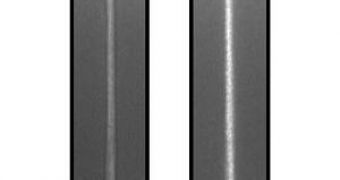Basically, any liquid column should be able to act as a guide for light, thus behaving similarly to optical fibers. The problem with these liquid fiber optics is that they become unstable after reaching a physical limitation known as the Rayleigh-Plateau instability which states that in free-fall conditions the length of the liquid column is in direct relation to its circumference. Exceeding this ratio immediately results in the breaking of the column.
Researchers Etienne Brasselet, Regis Wunenburger and Jean-Pierre Delville of the University of Bordeaux now created a model explaining how columns of liquid exceeding the Rayleigh-Plateau ratio can be stabilized with the help of light, at the same time proving that the liquid optic fiber can be tuned with light radiation. The effect of liquid column stabilization with light was discovered nearly four years ago by Delville, although he could not explain the mechanism behind the phenomenon.
The Bordeaux team now reveals that the stability of the column can be accounted for through radiation pressure, which is pushed against the cylindrical boundary of the liquid optic fiber in order to overcome the surface tension of the liquid. Following the predictions of the model, they then created liquid optical fibers with lengths up to 100 times that of their diameter.
"Strictly speaking, here is the main idea. Squeeze a drop of water between the thumb and the index finger, and then move the two fingers away from each other. The drop takes the form of a small liquid fiber. Stretch still a little more and this fiber breaks in two daughter drops under the influence of surface stresses in order to minimize the energy associated with the increase in water-air surface due to stretching," explained Delville.
However, if electromagnetic radiation is propagated through the liquid, then the pressure of radiation (the electromagnetic field) will partially counteract the Laplace pressure, or the surface stresses. This way the radius of the column can be modified only with light, responding accordingly to the intensity of the laser beam.
"The radius and the length of induced fibers being respectively micrometric and millimetric, these results allow us to advance a microfluidic approach of self-adapted optical guiding while proposing an original answer to the stabilization of liquid columns, a problem studied for the first time by Rayleigh more than one hundred years ago," said Delville.
During the experiments the team used a near-critical phase-separated liquid mixture kept at a temperature of 35 degrees Celsius inside of which an argon ion laser beam was pumped. As soon as the laser was aimed in the liquid column, it turned to a stable form guiding the beam perfectly down its length.

 14 DAY TRIAL //
14 DAY TRIAL //